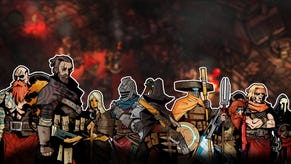With Pitfall II, Atari Platformers Became More Than Just Running and Jumping
David Crane's adventurous sequel pushed creative and technical boundaries.
This article first appeared on USgamer, a partner publication of VG247. Some content, such as this article, has been migrated to VG247 for posterity after USgamer's closure - but it has not been edited or further vetted by the VG247 team.
Donkey Kong may not have been gaming's first example of platformer -- that is, a game in which the protagonist runs and jumps across platforms -- but it was the first to matter. And the first truly meaningful follow-up came from Activision designer David Crane, who gave the world Pitfall! the next year.
Pitfall! didn't involve quite as many actual platforms as Donkey Kong had, but it certainly featured plenty of running and jumping. Rather than navigate broken bits of girder in a ravaged construction site, Pitfall! took a cue from Raiders of the Lost Ark and sent a lone adventurer dashing across a jungle in search of treasures, dodging alligators, scorpions, and (why did it have to be) snakes. Be it leaping over pits, swinging across pools of quicksand, hopping across the heads of 'gators like a bad James Bond set piece, Pitfall Harry used his platforming skills in pursuit of a different kind of game than his single-screen arcade contemporaries.
Pitfall! feels admittedly primitive compared to latter-day platformers, with flip-screen scrolling and simple two-level world design, yet it marked an important moment not only for the genre but for the medium at large. It introduced the idea that fast-paced action games could take place in settings rather than simply exist as isolated scenarios. Pitfall!'s quest dropped players into a jungle maze, one whose simple visuals belied structural complexity (traveling underground took you along a different route than going overland) and required both twitch skill and mental discipline to master.

These ideas didn't really and truly come into their own, however, until the sequel. Pitfall II: The Lost Caverns took a bold step forward for action games, giving players a massive non-linear playground in which to poke around. It pushed the limits of the humble Atari 2600 (even going so far as to include a custom co-processor in the cartridge, similar to what Nintendo would do to extend the functionality of NES and Super NES games) while incorporating some decidedly forward-thinking design concepts into the basic framework of the original Pitfall!
For starters, Pitfall II dispensed with the concept of limited lives; Harry now could spelunk to his heart's content, and the only consequence to a poorly executed run-in with the hazards of nature would be to lose some points he'd earned from treasure while being cast back to a checkpoint -- one of the first-ever instances of an in-game check point. The entire adventure was the same score-chasing treasure hunt as the first Pitfall!, but exploded into a much more elaborate world.
Where Pitfall! consisted of a seemingly endless line of screens linked side-by-side, Pitfall II's world was only eight screens wide. However, its underground caverns descended a whopping 27 screens downward, with three tiers of platforms in most screens rather than the two levels of Pitfall!'s design. Screens interconnected with one another on different levels, rendering the underground an intricate maze. Further complexity came in the form of elements like the balloon, which players could use to ascend the cave's central chasm to reach otherwise inaccessible areas. While it's entirely possible to complete the game with a perfect score in slightly more than 10 minutes....
...learning the ins and outs of the adventure and mastering the design of the subterranean labyrinth required hours of effort and most likely a detailed map on graph paper. Even with the unconventional lenience of the checkpoint system, truly mastering Pitfall II was far more difficult than completing its comparatively simple predecessor.
Pitfall II did abandon some popular conventions of its predecessor -- no more snapping alligators, no more swinging across vines while yodeling like an 8-bit Tarzan -- but these sacrifices were tradeoffs that made for the biggest, most intricate game ever seen on Atari's aging 2600 console. Its special built-in processor chip allowed it to incorporate dynamic, harmonized background music, something unheard of on the 2600. And when the game made its way to other platforms, the programmers behind those ports even added in a special "second quest" that revamped the labyrinth layout and boosted the difficult of enemy patterns.
Most importantly of all, though, Pitfall II brought Pitfall!'s exploration together with genuine platforming: Completing the game required not only hops to evade enemies and cross pits, but also huge leaps to reach out-of-the-way secrets and areas. Plus, Harry now gained the ability to swim. In the style of non-linear platformers to come, such as Metroid, there was no such thing as death by falling; dropping into a pit simply led Harry to another screen, and a vast underground lake lined the bottom of the game world. In many ways, it was a game years ahead of its time.

Of course, as often happens when sophisticated design meets limited technology, Pitfall II suffers the ravages of age. The 2600 version in particular suffers from incredibly repetitive graphics, making the underground maze much more difficult to navigate than it might otherwise be. Just about every screen beneath the surface of the jungle looks practically the same as any other, with only minor details to differentiate it from the adjacent room. Even with his special add-on chip, Crane was up against hard limitations of 2600 cartridge storage space.
Still, despite its shortcomings and the, shall we say, pitfalls of programming or 2600, Pitfall II was an incredible piece of game design that marked an important moment in the evolution of the platformer genre. While it ended up being somewhat overlooked compared to its predecessor thanks to arriving in the midst of the U.S. video game industry's tragical collapse, it definitely shouldn't be forgotten.









